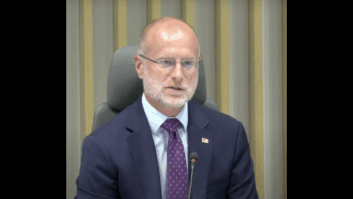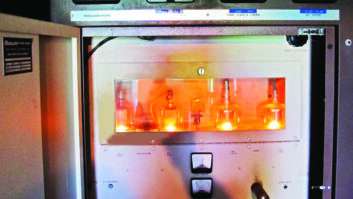Forgotten modulation methods
Mar 1, 2008 12:00 PM, By John Battison, P.E., technical editor, RF
Electrified telegraphy was the first practical use of electricity for long-distance communication. This was a tremendous improvement over flashing lights and waving signal flags. The well-known Morse code was an essential part of the system. The requirement for accurate knowledge and use of the Morse Alphabet quickly brought a requirement for voice communication. Various inventors around the world, including the ubiquitous Bell and Edison, devised methods of electronic voice communication using wires. This, of course, led to a requirement for a wireless voice communication system.
Wireless communication was first accomplished by using spark wireless code transmitters with their typical ragged spark tone characteristic. Unfortunately, it was not possible to use anyone’s microphone to efficiently and understandably modulate the spark transmissions. And so, as wireless communication improved, methods of generating continuous waves were developed. This also led to improved long-distance wireless telegraphic communication still using the Morse code and later to teletype operation.
The use of wireless signals produced the CW and ICW signals. Older hams will no doubt remember these symbols. They stood for continuous wave and interrupted continuous waves and required use of the Morse code. In order to make a continuous wave convey voice information it was necessary to modulate or change the nature of a continuous wave.

Figure 1. A vector diagram comparing the carrier and peak levels in out phasing modulation.
Vacuum tubes had not yet been developed and Arc transmitters (and later the Alexanderson alternator) were the main sources of continuous waves. Modulation of such waves was produced by inserting a carbon microphone in the antenna lead. This was somewhat effective, but as might be expected, microphones tended to overheat as antenna currents increased, carbon granules arced and audio quality suffered in general.
Then came the introduction of the vacuum tube and such microphone problems vanished, but a new problem developed. This problem, which was tackled by many engineers, was how to impress the signal voltages developed by the microphone onto the continuous wave (carrier) with the greatest efficiency. As various circuits were devised and patented, and as the widespread manufacture and sale of radio transmitting equipment increased, many efforts were made to develop new and different modulating circuits, and thus avoid the payment of license fees. Radio magazine has carried articles on many of the various modulation systems and in this issue we shall talk about the out phasing method of modulation.
Out phasing modulation
Early in the 1930s French engineer Henri Chireix devised an ingenious method of modulation that he named most appropriately out phasing. It was based on the result of combining two out-of-phase voltages. This produces a fluctuating signal voltage that varies in amplitude as the audio signals change. This voltage, after amplification, drives a power amplifier stage with properly amplitude-modulated RF. It’s interesting to note the similarity between this and the Doherty System. Each method uses phase relationship to accomplish its purpose. The famous RCA Ampliphase transmitter used the out phasing modulation system.

Figure 2. With phase modulation, V2 audio causes the impedance of the plate load to swing between positive and negative. The RF output therefore varies with phase.
As in most of the useful developments in radio engineering, a good knowledge of mathematics leads to the generation of new ideas. In the case of out phasing modulation the use of vectors simplifies understanding of the system and its development. When two signals of equal amplitude with a phase difference are combined, the magnitude of the resulting vector is determined by the phase difference. When the difference in phase is 180 degrees and the resulting vector is zero they have effectively canceled each other. As the phase difference varies between zero and 180 degrees, the magnitude (within limits) is determined by the difference between the phases. However, 90 degrees is the minimum phase separation allowable before quality suffers and undesirable effects occur.
This limits the positive peak attainable because at small angles the vector sum does not change as quickly as it does with larger angular differences. In other words, the positive peak would be flattened with undesirable consequences.
In practice it is usual to establish a phase difference of about 45 degrees between the two signals. Figure 1 shows this relationship.
Basic phase modulation of an RF signal can be produced in the circuit shown in Figure 2 is used as a variable resistance connected in series with the plate circuit. As this resistance varies, the plate load impedance will swing from negative to positive (the phase thus changing without a change in amplitude). A practical transmitter might consist of an oscillator with two output channels 180 degrees apart on the operating frequency. One signal is advanced by 22.5 degrees and the other one retarded by the same amount. Phase modulation then takes place on each channel. Because phase modulation takes place at a low level, and several stages in the series are needed to deliver the required signal to drive the IPA, which is grid modulated. The PA follows basically the circuit shown in Figure 3.

Figure 3. The phase-modulated drive from the outputs of V1 and V2 are combined in the common load (RCL).
The output of each tube reaches the load resistor through very necessary individual 90 degrees networks. When two currents, equal in magnitude and phase, are fed into a common load, the load impedance seen by each tube will be doubled. It follows that when the signals are exactly out of phase, i.e. 180 degrees apart, the load impedance will fall to zero. This would be a very bad operating condition for a tube receiving grid drive. The 90 degrees networks have the valuable property of inverting the impedance seen, thus ensuring that each tube’s impedance remains reasonably high as required. For example, if the plate load impedance for a tube should fall to a low value, the 90 degrees network will invert it and maintain a desirable plate load impedance until the conditions change.
Because the 90 degrees network circuits do not normally have the high Q of a normal PA plate circuit, it was necessary to include a harmonic filter (not shown) in the transmitter output to meet FCC requirements.
E-mail Battison at[email protected].







